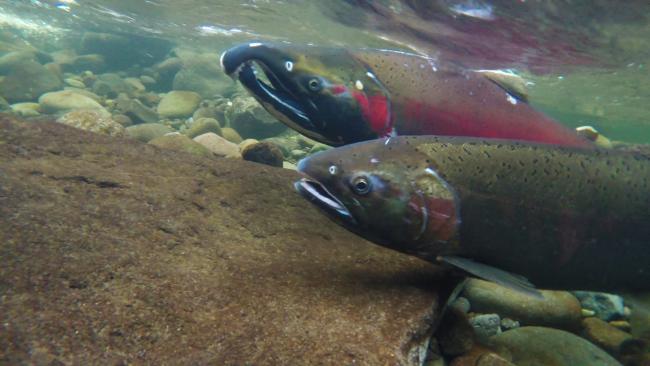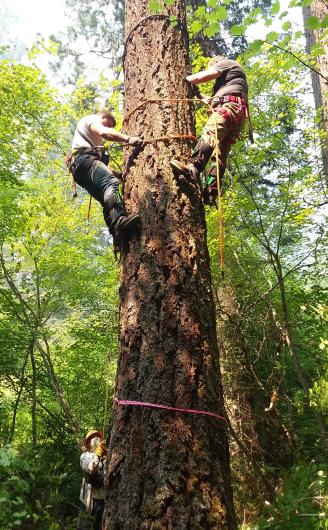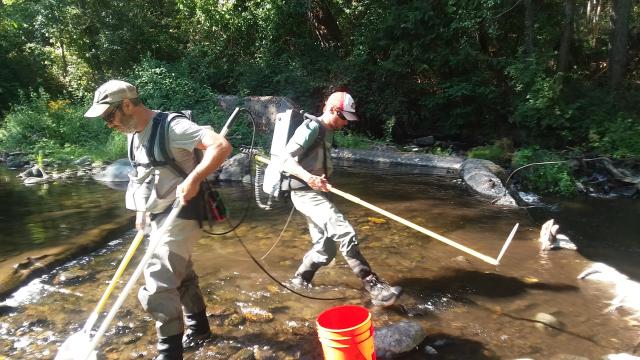Looking at rivers from a fish’s perspective in Southwest Oregon
Listen
Subscribe
Related Content
BLM manages millions of acres of forested lands in a checkerboard pattern through eighteen counties of western Oregon. Critical to the health of the land are the rivers and streams that snake their way through these mountainous areas. BLM is one of many agencies concerned about providing strong habitat for migrating coho salmon, Chinook, steelhead, and other species. Consequently, BLM works with many partners to maintain and improve watersheds.
In this episode of "On The Ground," we interview Rose Hanrahan, a fish biologist in Medford, Oregon who works in the BLM's Butte Falls Field Office. The Field Office received more than $700,000 from the Bipartisan Infrastructure Law and the Inflation Reduction Act to improve fish habitat. Hanrahan describes why a river that benefits fish might look very different from a recreational river.
Transcript
HOWELL: In Western Oregon, the Bureau of Land Management is responsible for millions of acres of forested lands. While harvesting trees to make material for houses and other buildings is a major use of the land, BLM is also responsible for maintaining or improving the environment, including the habitat for endangered fish.
HOWELL: I’m David Howell, and you’re listening to “On The Ground, A Bureau of Land Management Podcast.” In Southwest Oregon’s Rogue River Valley, BLM is one of many agencies working to improve rivers and streams. In BLM’s Butte Falls Field Office in Medford, Rose Hanrahan is one of BLM’s Fish Biologists concerned about the watershed. For me, I’ve enjoyed streams that are nice and open, great for photography. But for Rose, a healthy river looks very different.
ROSE HANRAHAN (BLM Butte Falls Field Office, Fish Biologist): Western Oregon is a wonderful place to work, and Southwest Oregon is pretty unique. We have a bunch of different sort of ecotones that come together down here in the valley -- it's sometimes referred to as “The Klamath Knot.” And we have a lot of different types of forests. So, we have everything from dry, oak-type forests to really big Doug fir trees with, you know, a shady understory. So, we have a little bit of everything here. We have a lot of creeks that might go dry in the summer and then we have some really, you know, large rivers like the Rogue River or the Illinois River. So it's pretty, it's a pretty interesting place to work.
HOWELL: It is. You sent me a wonderful photo earlier that had, kind of, all these logs that were toppled in on top of themselves. You know, it doesn't really lend the idea of a nice navigable... either river or forest. Tell me a little bit about what's going on with all those logs stacked on top of each other.
HANRAHAN: For a long time, aquatic managers, fish biologists were taking wood out of streams. We had thought that the wood was an impediment to fish, that all this wood in the stream made it impossible for fish to make it up. And we removed it. The 70s, even into the 80s, we were doing this. Now we know better. And we know that that fish is really… that for fish, those big logs and that big chunky wood is really, really important. The wood provides places for fish to rest, places for fish to hide. We can use those logs to help accentuate pools, which is really important habitat for fish.
And so now we're putting that wood back in. And for somebody just looking at the picture like the one that I shared with you, it looks like a hot mess, and quite frankly, that's what we want. We're not building a dam. We're not building something, you know, that's gonna be on the cover of a magazine somewhere. We're building something that hopefully would mimic what nature would do. And that's part of our guidance for when we do these log structures, is try to make it kind of -- you know, “junk it up” a little bit so that, you know, you've got some logs pointed this way, some logs pointed that way. We're trying to mimic what nature might do. And when you have an event where wood might naturally slide into the creek, it's messy, but that's what fish really like.
HOWELL: So they're able to, they're able to swim around and we think it's a very large piece of wood that's falling right into the river, [blocking it]. But that's not really necessarily the case, right? I mean, there's places for the fish to navigate around, is what you're saying?
HANRAHAN: That's actually a question that – basically, everybody that looks at those log structures, that's the first question that they'll ask: “Oh well, how do fish get past?” But when you're looking at it from a fish perspective, that's exactly what they want. And then the stream will find a way. Sometimes we're actually adding those logs because we want to add a little bit of sinuosity: we want the stream to kind of go back and forth a little bit because that's sort of a sign of a healthy stream.
HOWELL: Yeah, instead of letting it go straight on down the hillside, as it were.
HANRAHAN: Yes, that's right.
HOWELL: Yeah, interesting. We should maybe talk about what species of fish that we have in a lot of these streams.
HANRAHAN: In Southern Oregon and southwest Oregon, the main fish that we target is our threatened and endangered species. For us in Butte Falls, that's coho salmon. And in other parts of the [BLM Medford] District, they have coho and Chinook that they will target. One of the cool things about these structures is that in helping one species, we’re helping many species. So, we can put these log structures in, and coho definitely will benefit from them, but all of the other fish species will, too. We have resident trout that will benefit from those structures. We have Chinook, coho, lamprey. We've also anecdotally looked at wildlife using those log structures as crossings. And, of course, there's stream bugs called macroinvertebrates, and some macroinvertebrates really love wood, and so it's really sort of this holistic approach for sort of an aquatic ecosystem uplift.
HOWELL: So Rose, before we started recording, you mentioned that your office, the Butte Falls Field Office, received about $500,000 for culvert replacement under the Inflation Reduction Act, another $270,000 from the Bipartisan Infrastructure Law for projects like the one you were just talking about – for putting more logs into the stream. And that’s just two of many projects happening in Western Oregon.
HANRAHAN: These BIL and IRA funds, those dollars have literally changed the landscape in the Rogue Valley for the better. Up to this point, we've really had to kind of compete with some, even with ourselves or other outside organizations for restoration dollars. And so having these dollars come down, it's a large amount of dollars over several years has enabled us to really take things and just run with them.
We used to do projects and get them what we call “shelf ready.” So we would analyze the project, and it would literally sit on the shelf waiting for dollars.
HOWELL: Right.
HANRAHAN: So now we don't really have to do that. We can get that project ready to go and then implement the project. And at the same time, our partners are implementing projects.
Something else that I wanted to mention that I think is really cool: the vast majority of these dollars that are coming into the valley stay in the valley. We're employing local contractors who spend their money at local businesses. They're supporting families -- those people have houses here, families here. So this is a big deal having these dollars come down -- and not only for restoration work for the ecology, the ecological uplift that's happening now -- but just being able to support families in the valley, it's a big deal.
HOWELL: Before we go, let’s mention some of the other organizations that are working with you in the Rogue Valley that, maybe, are doing the same things that you’re doing.
HANRAHAN: There are so many wonderful organizations at work in the valley right now. We have a couple of watershed councils. The Rogue River Watershed Council and the Applegate Partnership and Watershed Council. They're doing fantastic work right now, removing fish barriers, improving riparian habitat. We have partnerships with Trout Unlimited. We work with The Nature Conservancy. There's uh, gosh, there's there's so many. There's soil and water conservation districts, and then each one of those also has their own partnerships. We've actually even worked with private individuals that are interested in doing work. Maybe they have a legacy structure, a culvert or something on their land and they own it, but they want to do something good there and they'll contact probably a watershed council or the BLM to do that. So, we just are able to work with so many wonderful organizations that are doing really good work in the valley right now.
HOWELL: I think maybe that's one story that needs to be told a little bit better. It's not as if it was just like one agency doing a little bit of work on that patch of ground. This is something that's happening with multiple agencies all up through a watershed.
HANRAHAN: That's right. Yeah. We're actually kind of trying to do more “ridge to ridge” type restoration. Some people will call it “valley to ridge” type restoration. And in Southern Oregon, we have a patchwork of land ownership. It's called O&C lands, and it's every other section: one's private, the next one's federal, the next one's private, the next one's federal. And so, if we were to only look at just BLM lands, we basically wouldn't be able to get anything done. If you want to improve a watershed, certainly, or sub-watershed or even just a single stream, you really have to work across those borders, and our partners have been invaluable in being able to do that.
HOWELL: Rose, thank you so much. I appreciate you taking some time with me.
HANRAHAN: Thank you so much for the opportunity! I really appreciate a chance to have a positive spotlight put on the BLM.
NARRATOR (Howell): Rose Hanrahan is a Fish Biologist from BLM’s Butte Falls Field Office in Medford Oregon. There was so much more that we talked about, and if you want to hear more, there are clips on other topics at our website on BLM.gov, along with the photos we talked about in our interview.
If you liked what you heard on this episode, we have a lot more stories. You can find us on iTunes, where you can follow our channel and get the latest updates each time we post a story.
I’m David Howell, thanks for joining me! I hope you’re planning your next trip out on public lands! If so, we’ll see you out there, “On The Ground.”





